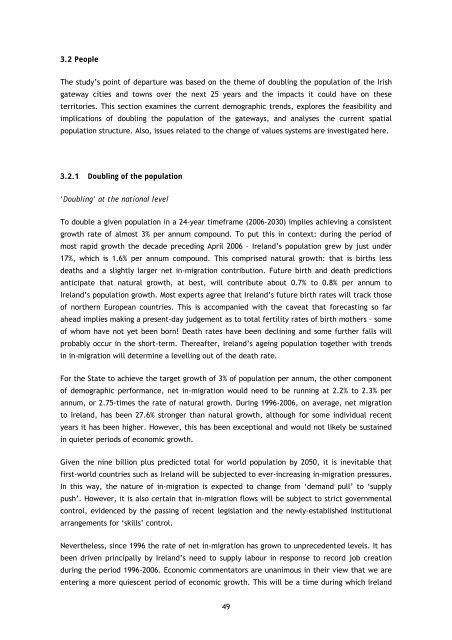TWICE THE SIZE - DIT Update - Dublin Institute of Technology
TWICE THE SIZE - DIT Update - Dublin Institute of Technology
TWICE THE SIZE - DIT Update - Dublin Institute of Technology
Create successful ePaper yourself
Turn your PDF publications into a flip-book with our unique Google optimized e-Paper software.
3.2 People<br />
The study’s point <strong>of</strong> departure was based on the theme <strong>of</strong> doubling the population <strong>of</strong> the Irish<br />
gateway cities and towns over the next 25 years and the impacts it could have on these<br />
territories. This section examines the current demographic trends, explores the feasibility and<br />
implications <strong>of</strong> doubling the population <strong>of</strong> the gateways, and analyses the current spatial<br />
population structure. Also, issues related to the change <strong>of</strong> values systems are investigated here.<br />
3.2.1 Doubling <strong>of</strong> the population<br />
‘Doubling’ at the national level<br />
To double a given population in a 24-year timeframe (2006-2030) implies achieving a consistent<br />
growth rate <strong>of</strong> almost 3% per annum compound. To put this in context: during the period <strong>of</strong><br />
most rapid growth the decade preceding April 2006 – Ireland’s population grew by just under<br />
17%, which is 1.6% per annum compound. This comprised natural growth: that is births less<br />
deaths and a slightly larger net in-migration contribution. Future birth and death predictions<br />
anticipate that natural growth, at best, will contribute about 0.7% to 0.8% per annum to<br />
Ireland’s population growth. Most experts agree that Ireland’s future birth rates will track those<br />
<strong>of</strong> northern European countries. This is accompanied with the caveat that forecasting so far<br />
ahead implies making a present-day judgement as to total fertility rates <strong>of</strong> birth mothers – some<br />
<strong>of</strong> whom have not yet been born! Death rates have been declining and some further falls will<br />
probably occur in the short-term. Thereafter, Ireland’s ageing population together with trends<br />
in in-migration will determine a levelling out <strong>of</strong> the death rate.<br />
For the State to achieve the target growth <strong>of</strong> 3% <strong>of</strong> population per annum, the other component<br />
<strong>of</strong> demographic performance, net in-migration would need to be running at 2.2% to 2.3% per<br />
annum, or 2.75-times the rate <strong>of</strong> natural growth. During 1996-2006, on average, net migration<br />
to Ireland, has been 27.6% stronger than natural growth, although for some individual recent<br />
years it has been higher. However, this has been exceptional and would not likely be sustained<br />
in quieter periods <strong>of</strong> economic growth.<br />
Given the nine billion plus predicted total for world population by 2050, it is inevitable that<br />
first-world countries such as Ireland will be subjected to ever-increasing in-migration pressures.<br />
In this way, the nature <strong>of</strong> in-migration is expected to change from ‘demand pull’ to ‘supply<br />
push’. However, it is also certain that in-migration flows will be subject to strict governmental<br />
control, evidenced by the passing <strong>of</strong> recent legislation and the newly-established institutional<br />
arrangements for ‘skills’ control.<br />
Nevertheless, since 1996 the rate <strong>of</strong> net in-migration has grown to unprecedented levels. It has<br />
been driven principally by Ireland’s need to supply labour in response to record job creation<br />
during the period 1996-2006. Economic commentators are unanimous in their view that we are<br />
entering a more quiescent period <strong>of</strong> economic growth. This will be a time during which Ireland<br />
49








